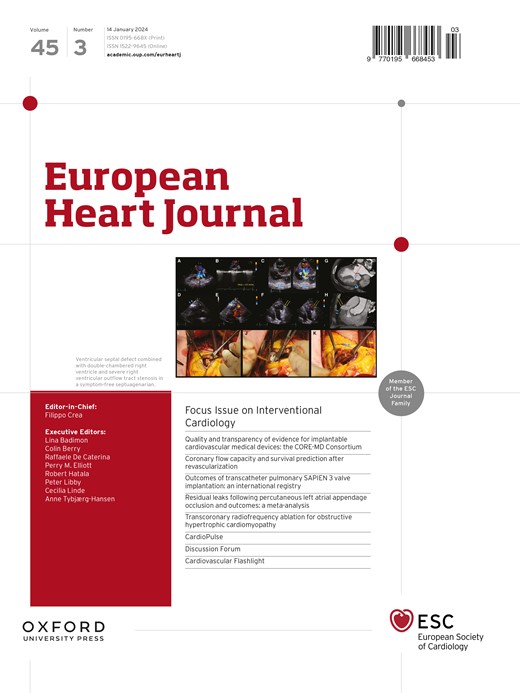Artificial intelligence-enhanced electrocardiography to predict regurgitant valvular heart diseases: an international study.
IF 35.6
1区 医学
Q1 CARDIAC & CARDIOVASCULAR SYSTEMS
引用次数: 0
Abstract
BACKGROUND AND AIMS Valvular heart disease (VHD) is a significant source of morbidity and mortality, though early intervention can improve outcomes. This study aims to develop artificial intelligence-enhanced electrocardiography (AI-ECG) models to diagnose and predict future moderate or severe regurgitant VHDs (rVHDs), including mitral regurgitation (MR), tricuspid regurgitation (TR), and aortic regurgitation (AR). METHODS The AI-ECG models were developed in a data set of 988 618 ECG and transthoracic echocardiogram pairs from 400 882 patients from Zhongshan Hospital, Shanghai, China. The AI-ECG models used a residual convolutional neural network with a discrete-time survival loss function. External evaluation was performed in outpatients from a secondary care data set from Beth Israel Deaconess Medical Center, Boston, USA, consisting of 34 214 patients with linked echocardiography. RESULTS In the internal test set, the AI-ECG models accurately predicted future significant MR [C-index 0.774, 95% confidence interval (CI) 0.753-0.792], AR (0.691, 95% CI 0.657-0.720), and TR (0.793, 95% CI 0.777-0.808). In age- and sex-adjusted Cox models, the highest risk quartile had a hazard ratio (HR) of 7.6 (95% CI 5.8-9.9, P < .0001) for risk of future significant MR, compared with the lowest risk quartile. For future AR and TR, the equivalent HRs were 3.8 (95% CI 2.7-5.5) and 9.9 (95% CI 7.5-13.0), respectively. These findings were confirmed in the transnational external test set. Imaging association analyses demonstrated AI-ECG predictions were associated with subclinical chamber remodelling. CONCLUSIONS This study developed AI-ECG models to diagnose and predict rVHDs and validated the models in a transnational and ethnically distinct cohort. The AI-ECG models could be utilized to guide surveillance echocardiography in patients at risk of future rVHDs, to facilitate early detection and intervention.人工智能增强心电图预测反流性瓣膜性心脏病:一项国际研究
背景和目的尽管早期干预可以改善预后,但瓣膜性心脏病(VHD)是发病率和死亡率的重要来源。本研究旨在开发人工智能增强的心电图(AI-ECG)模型来诊断和预测未来中度或重度反流性室性心律失常(rvhd),包括二尖瓣反流(MR)、三尖瓣反流(TR)和主动脉反流(AR)。方法采用上海中山医院400 882例患者988 618对心电图和经胸超声心动图资料建立人工智能心电图模型。AI-ECG模型使用带有离散时间生存损失函数的残差卷积神经网络。外部评估来自美国波士顿Beth Israel Deaconess医疗中心二级保健数据集的门诊患者,包括34,214例超声心动图患者。结果在内部测试集中,AI-ECG模型能准确预测未来显著MR [c指数0.774,95%可信区间(CI) 0.753-0.792]、AR (0.691, 95% CI 0.657-0.720)和TR (0.793, 95% CI 0.777-0.808)。在年龄和性别校正的Cox模型中,与最低风险四分位数相比,最高风险四分位数的未来显著MR风险风险比(HR)为7.6 (95% CI 5.8-9.9, P < 0.0001)。对于未来的AR和TR,等效hr分别为3.8 (95% CI 2.7-5.5)和9.9 (95% CI 7.5-13.0)。这些发现在跨国外部测试集中得到了证实。影像学关联分析显示AI-ECG预测与亚临床腔室重构相关。本研究建立了AI-ECG模型来诊断和预测rvhd,并在跨国和不同种族的队列中验证了该模型。AI-ECG模型可用于指导未来有rvhd风险的患者的超声心动图监测,以促进早期发现和干预。
本文章由计算机程序翻译,如有差异,请以英文原文为准。
求助全文
约1分钟内获得全文
求助全文
来源期刊

European Heart Journal
医学-心血管系统
CiteScore
39.30
自引率
6.90%
发文量
3942
审稿时长
1 months
期刊介绍:
The European Heart Journal is a renowned international journal that focuses on cardiovascular medicine. It is published weekly and is the official journal of the European Society of Cardiology. This peer-reviewed journal is committed to publishing high-quality clinical and scientific material pertaining to all aspects of cardiovascular medicine. It covers a diverse range of topics including research findings, technical evaluations, and reviews. Moreover, the journal serves as a platform for the exchange of information and discussions on various aspects of cardiovascular medicine, including educational matters.
In addition to original papers on cardiovascular medicine and surgery, the European Heart Journal also presents reviews, clinical perspectives, ESC Guidelines, and editorial articles that highlight recent advancements in cardiology. Additionally, the journal actively encourages readers to share their thoughts and opinions through correspondence.
 求助内容:
求助内容: 应助结果提醒方式:
应助结果提醒方式:


